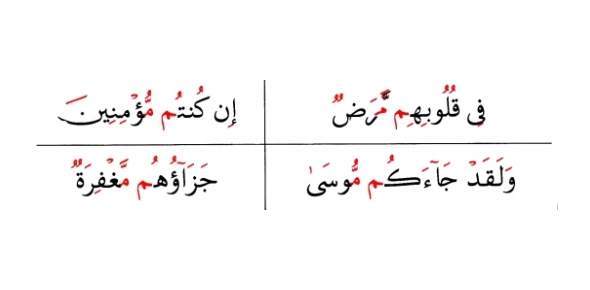Tajweed Theory Test

- 1.
What do we do when hamzatul wasl comes in between of the ayah
- A.
We read that
- B.
We skip that and make it silent
Correct Answer
B. We skip that and make it silentExplanation
When hamzatul wasl comes in between of the ayah, we skip it and make it silent.Rate this question:
-
- 2.
How many kinds of hamza are there?
- A.
4
- B.
2
- C.
3
- D.
5
Correct Answer
B. 2Explanation
There are two kinds of hamza.Rate this question:
-
- 3.
Which rule is found in the below given pictures?
- A.
Ikhfa shafawi
- B.
Iz'har shafawi
- C.
Idghaam shafwi
Correct Answer
C. Idghaam shafwiExplanation
The correct answer is Idghaam shafwi. Idghaam shafwi is a rule in Tajweed which occurs when a noon saakinah or tanween is followed by a yaa saakinah. In this case, the noon saakinah or tanween is merged or assimilated with the following yaa saakinah, resulting in the sound being elongated. This rule is found in the given pictures.Rate this question:
-
- 4.
What is the meaning of Iqlab?
- A.
To produce echo sound
- B.
To take voice into nose
- C.
To change one thing into other
- D.
None of the above
Correct Answer
C. To change one thing into otherExplanation
Iqlab is a term used in Arabic pronunciation rules. It refers to the change of a nasal consonant sound into a non-nasal sound. This change occurs when a nasal consonant, such as "n" or "m," is followed by a non-nasal consonant, such as "b" or "p." The nasal sound is assimilated into the following non-nasal sound, resulting in a single non-nasal sound. Therefore, the correct meaning of Iqlab is "to change one thing into other," as mentioned in the given answer.Rate this question:
-
- 5.
What does izhar means?
- A.
Skipping
- B.
Reading clearly
- C.
Merging form one letter into another
- D.
All of the above
Correct Answer
B. Reading clearlyExplanation
Izhar means reading clearly, which refers to pronouncing each letter distinctly and clearly without merging it into another letter.Rate this question:
-
- 6.
How many letters are there for QALQALA?
- A.
5
- B.
7
- C.
2
- D.
4
Correct Answer
A. 5Explanation
Qalqala is an Arabic term used in Tajweed, the rules of reciting the Quran. Qalqala letters are six Arabic letters that have a specific pronunciation when they appear with a sukoon (a diacritic indicating the absence of a vowel sound). The Qalqala letters are ق (qaf), ط (ta), ب (ba), ج (jeem), د (dal), and ك (kaf). In the given question, the word Qalqala itself has seven letters, but the question is asking about the number of letters in the word Qalqala, not the word itself. Therefore, the answer is 5, as there are five letters in the word Qalqala.Rate this question:
-
- 7.
How do we read "RAA" in the given example?
- A.
Light
- B.
Heavy
Correct Answer
B. HeavyExplanation
In the given example, the letters "RAA" are read as "Heavy".Rate this question:
-
- 8.
How do we read "RAA" in the given example?
- A.
Heavy
- B.
Light
Correct Answer
A. Heavy -
- 9.
How do we read "RAA" in given example
- A.
Light
- B.
Heavy
Correct Answer
A. Light -
- 10.
Which rule is found in this example?
- A.
Ikhfa
- B.
Izhar
- C.
Idgham with Gunnah
- D.
Iqlaab
Correct Answer
D. IqlaabExplanation
Iqlaab is the rule found in this example. Iqlaab is a rule in Tajweed that occurs when a noon saakinah or tanween is followed by a laam letter. In this case, the example does not provide any specific details or context, so it is not possible to provide a more detailed explanation of how the rule is applied.Rate this question:
-
- 11.
What are the letters of Izhar (hurooful Halqiyyah)
- A.
ج ل د ر
- B.
ت ث ج ب
- C.
ء ه ع ح غ خ
- D.
ق ط ب ج د
Correct Answer
C. ء ه ع ح غ خExplanation
The correct answer is ء, ه, ع, ح, غ, and خ. These letters are known as "hurooful Halqiyyah" in Arabic. They are called so because they are pronounced with the help of the throat or the vocal cords. These letters have a distinct sound and require airflow from the throat to produce the correct pronunciation.Rate this question:
-
- 12.
This example belongs to
- A.
Iqlaab
- B.
Ikhfaa
- C.
Idgham
- D.
Noon qutni (tiny noon)
Correct Answer
D. Noon qutni (tiny noon)Explanation
This example belongs to the concept of "Noon qutni" or "tiny noon" in Arabic pronunciation rules. Noon qutni occurs when a noon saakinah or tanween is followed by a qutni letter, which includes the letters ت, ث, د, ذ, ر, ز, س, ش, ص, ض, ط, ظ, ل, ن, and ي. In this case, the example is likely demonstrating the pronunciation of a noon saakinah or tanween followed by one of these qutni letters.Rate this question:
-
- 13.
How many letters are there for Ikhfa?
- A.
10
- B.
15
- C.
20
- D.
6
Correct Answer
B. 15Explanation
Ikhfa is a concept in Arabic pronunciation where a letter is pronounced with a slight nasal sound. In the Arabic alphabet, there are 15 letters that can be pronounced with Ikhfa. Therefore, the correct answer is 15.Rate this question:
-
- 14.
What does idhgham means?
- A.
To merge
- B.
To change
- C.
To remove
- D.
None of the above
Correct Answer
A. To mergeExplanation
Idhgham is an Arabic term that refers to the merging or assimilation of two adjacent sounds or letters in pronunciation. It is a phonetic rule in Arabic language where certain letters are merged or assimilated into each other to create a smoother and more fluid pronunciation. This process of merging helps in the correct articulation of words and is an important aspect of proper Arabic pronunciation.Rate this question:
-
- 15.
Which are the letter of idgham without Gunnah?
- A.
ج ح
- B.
ل ر
- C.
م ب
- D.
س ف
Correct Answer
B. ل رExplanation
The letters ل and ر are examples of idgham without gunnah. Idgham without gunnah occurs when a نون ساكنة or تنوين is followed by a لام or راء, and the sound of the نون ساكنة or تنوين is assimilated into the لام or راء without any nasal sound. In this case, the نون ساكنة or تنوين is not pronounced separately but is merged with the لام or راء.Rate this question:
-
- 16.
Qalqalah letters are collected in؟
- A.
فحثه شخص سكت
- B.
فر من لُب
- C.
قطب جد
- D.
خص ضغط قظ
Correct Answer
C. قطب جدExplanation
The correct answer is "قطب جد". Qalqalah letters are collected in this word. Qalqalah is a term used in Arabic to refer to the echoing or reverberation of certain letters when they are pronounced. The letters that have qalqalah are ق ط ب ج د. In the word "قطب جد", both ق and ج are qalqalah letters.Rate this question:
-
- 17.
Laam in (الله)
- A.
Always heavy
- B.
Always light
- C.
Sometimes heavy & sometimes light according to previous word
Correct Answer
C. Sometimes heavy & sometimes light according to previous wordExplanation
The Arabic letter "Laam" (الله) can have different pronunciations depending on the previous word. It can be pronounced as heavy or light based on the phonetic rules of the Arabic language. Therefore, the correct answer is that it is sometimes heavy and sometimes light according to the previous word.Rate this question:
-
- 18.
When the letter khaa (خ) follows a noon saakinah, which tajweed rule must be exercised?
- A.
Ikhfaa
- B.
Izhaar
- C.
Iqlaab
- D.
Idghaam
Correct Answer
B. IzhaarExplanation
When the letter khaa (خ) follows a noon saakinah, the tajweed rule that must be exercised is Izhaar. Izhaar means to pronounce the letter clearly without any nasal sound or merging it with the noon saakinah. This rule is applied when there is no specific symbol or sign indicating a different pronunciation.Rate this question:
-
- 19.
If a word starting with hamzatul wasl has a fat-ha on the third letter, the ruling for pronouncing the hamzatul wasl is...
- A.
Hamzatul Was is sounded with a kasrah
- B.
Hamzatul Wasl is sounded with a fat-ha
- C.
Hamzatul Wasl is sounded with a dammah
- D.
Hamzatul Wasl is said with a sukoon
Correct Answer
A. Hamzatul Was is sounded with a kasrahExplanation
The correct answer is "Hamzatul Was is sounded with a kasrah." When a word starting with hamzatul wasl has a fat-ha on the third letter, the hamzatul wasl is pronounced with a kasrah. This is because the hamzatul wasl acts as a connector and does not have its own vowel sound. Instead, it takes on the vowel sound of the following letter, which in this case is a kasrah. Therefore, the hamzatul wasl is sounded with a kasrah.Rate this question:
-
- 20.
There are 4 words in the Quran which are an exception to the ikhfaa' for noon al-saakinah... these four words are:
- A.
1. Dunya 2. Sinwaan 3. Bunyaan 4. Antum
- B.
1. Sinwaan 2. Bunyaan 3. Anfusakum 4. Qinwaan
- C.
1. Dunya 2. Sinwaan 3. Qinwaan 4. Bunyaan
- D.
1. Qinwaan 2. Anhaar 3. Dunya 4. Antum
Correct Answer
C. 1. Dunya 2. Sinwaan 3. Qinwaan 4. BunyaanExplanation
The correct answer is 1. Dunya 2. Sinwaan 3. Qinwaan 4. Bunyaan. These four words are exceptions to the rule of ikhfaa' for noon al-saakinah. In ikhfaa', the noon al-saakinah is pronounced with a nasal sound, but in these words, the noon al-saakinah is pronounced clearly without any nasalization. Therefore, they do not follow the general rule of ikhfaa'.Rate this question:
-
- 21.
The letters of idgham with gunnah are as follow
- A.
ل م ص ب
- B.
ي ن م و
- C.
ج م ق ث
- D.
د ذ ر ق
Correct Answer
B. ي ن م وExplanation
The correct answer is ي ن م و. These letters are the ones that have idgham with gunnah. In idgham with gunnah, the letters ن, م, and و are pronounced with a nasal sound and are merged with the following letter. The letter ي is also pronounced with a nasal sound but is not merged with the following letter. Therefore, these letters are the ones that have idgham with gunnah.Rate this question:
-
- 22.
How many kinds of Idgham are there?
- A.
5
- B.
3
- C.
1
- D.
2
Correct Answer
D. 2Explanation
In Tajweed (the rules of Quranic recitation), there are two main kinds of Idgham:
Idgham with Ghunnah (nasal sound):
This occurs when one of the letters ن (Nun) or م (Meem) is followed by one of the letters of Yarmaloon (ي, ر, م, ل, و, ن) with the exception of ر (Ra) and ل (Lam). The letters for Idgham with Ghunnah are: ي, ن, م, و.
Example: من يجيب (min yujeeb)
Idgham without Ghunnah:
This occurs when one of the letters ن (Nun) or م (Meem) is followed by one of the letters ر (Ra) or ل (Lam).
Example: من ربهم (min rabbihim)
Idgham simplifies the recitation by merging certain consonants together, making the pronunciation smoother and more fluent.Rate this question:
-
Quiz Review Timeline +
Our quizzes are rigorously reviewed, monitored and continuously updated by our expert board to maintain accuracy, relevance, and timeliness.
-
Current Version
-
Jul 03, 2024Quiz Edited by
ProProfs Editorial Team -
Jul 09, 2020Quiz Created by
Peacetkrhifz Competition
 Back to top
Back to top





.webp)


